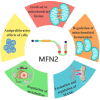The structure and function of mitofusin 2 and its role in cardiovascular disease through mediating mitochondria-associated endoplasmic reticulum membranes
- PMID: 40520935
- PMCID: PMC12163069
- DOI: 10.3389/fcvm.2025.1535401
The structure and function of mitofusin 2 and its role in cardiovascular disease through mediating mitochondria-associated endoplasmic reticulum membranes
Abstract
Cardiovascular disease (CVD) remains a leading cause of death globally, posing a major public health challenge. Due to the complexity of CVD's etiology, understanding its pathogenesis has been a significant challenge and research focus. In recent years, the communication between organelles has gained increasing attention, with mitochondria-associated endoplasmic reticulum (ER) membranes (MAMs) emerging as a key structural component that facilitates dialogue between the mitochondria and the ER. Numerous studies have highlighted that proteins located in MAMs may play a role in the development of CVD. Among these, mitofusin 2 (MFN2), a protein found on the outer mitochondrial and ER membranes, has garnered particular interest due to its widespread presence in MAMs. This review aims to sort out current research on MFN2, focusing on its potential involvement in myocardial protection through its mediation of MAMs. We discuss how MFN2-mediated MAMs may contribute to the protection against various CVDs, including myocardial ischemia/reperfusion injury, diabetic cardiomyopathy, dilated cardiomyopathy, pathological myocardial hypertrophy, cardiotoxicity, and heart failure. However, given the functional diversity of MFN2, the current body of research remains controversial, and further studies are urgently needed to clarify its precise mechanisms of action.
Keywords: cardioprotection; cardiovascular disease; endoplasmic reticulum; mitochondria; mitochondria-associated endoplasmic reticulum membranes; mitofusin 2.
© 2025 Lv, Chen, Li, Liao, Fang, Cheng and Peng.
Conflict of interest statement
The authors declare that the research was conducted in the absence of any commercial or financial relationships that could be construed as a potential conflict of interest.
Figures



Similar articles
-
Mitochondrial redox-driven mitofusin 2 S-glutathionylation promotes neuronal necroptosis via disrupting ER-mitochondria crosstalk in cadmium-induced neurotoxicity.Chemosphere. 2021 Jan;262:127878. doi: 10.1016/j.chemosphere.2020.127878. Epub 2020 Aug 6. Chemosphere. 2021. PMID: 33182097
-
Mitochondria-associated endoplasmic reticulum membranes as a therapeutic target for cardiovascular diseases.Front Pharmacol. 2024 Apr 17;15:1398381. doi: 10.3389/fphar.2024.1398381. eCollection 2024. Front Pharmacol. 2024. PMID: 38694924 Free PMC article. Review.
-
Mitochondria-associated endoplasmic reticulum membranes and myocardial ischemia: from molecular mechanisms to therapeutic strategies.J Transl Med. 2025 Mar 6;23(1):277. doi: 10.1186/s12967-025-06262-3. J Transl Med. 2025. PMID: 40050915 Free PMC article. Review.
-
Mitofusin2 Ameliorated Endoplasmic Reticulum Stress and Mitochondrial Reactive Oxygen Species Through Maintaining Mitochondria-Associated Endoplasmic Reticulum Membrane Integrity in Cisplatin-Induced Acute Kidney Injury.Antioxid Redox Signal. 2024 Jan;40(1-3):16-39. doi: 10.1089/ars.2022.0178. Epub 2023 Jun 22. Antioxid Redox Signal. 2024. PMID: 37053105
-
Mitochondria-associated endoplasmic reticulum membranes (MAMs): Possible therapeutic targets in heart failure.Front Cardiovasc Med. 2023 Jan 26;10:1083935. doi: 10.3389/fcvm.2023.1083935. eCollection 2023. Front Cardiovasc Med. 2023. PMID: 36776252 Free PMC article. Review.
References
Publication types
LinkOut - more resources
Full Text Sources

